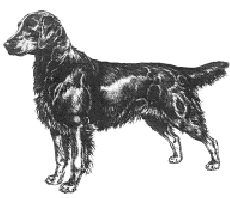Flat-coated Retriever
General Information - Flat-coated Retriever

Group:
Gundog
Size:
large
Lifespan:
10-14 years
Exercise:
medium
Grooming:
low
Trainability:
very high
Watchdog ability:
high
Protection ability:
low
Area of Origin:
England
Date of Origin:
1800s
Other Names:
none
Original Function:
water retrieving
History
The Flat-Coated Retriever was developed in the 1800's by crossing several already established breeds, including the Irish Setter, Labrador, Water Dog, and the St. John's Newfoundland, though one source also mentions the Collie. The breed became popular in Britain amongst the gamekeepers due to its excellent working ability. Due to the two World Wars there was a decline in numbers despite a small group of dedicated breeders maintaining the viability of the breed, until the return of many gamekeepers from World War Two. Since then, numbers have steadily increased.
The Flat-Coated Retriever deserves more attention, as he is not only an excellent bird dog and swimmer but also an outstanding family dog. These dogs are gifted with a fine intuition and an excellent sense of smell. The Flat-Coated Retriever is used above all for retrieving on plains and in areas thick with trees and bushes. They are good swimmers and also work well in marshy areas.
Temperament
This good-natured intelligent breed loves making friends. With its stable temperament, the flat coated retriever makes an excellent family dog and loves being around children. They have a puppy-like demeanor throughout their lives. The Flat Coated Retriever is quiet indoors and very active outdoors.
Upkeep
This active dog needs daily exercise and fun, and especially enjoys the chance to hunt or swim. This is a family-oriented dog that does best when allowed to live inside and play outside. Its coat needs only weekly brushing and little, if any, minor trimming occasionally.
Flat-coated Retriever
A breed standard is the guideline which describes the ideal characteristics, temperament, and appearance of a breed and ensures that the breed is fit for function with soundness essential. Breeders and judges should at all times be careful to avoid obvious conditions and exaggerations, as well as being mindful of features which could be detrimental in any way to the health, welfare or soundness of this breed.
Breed Standard - Flat-Coated Retriever
 General Appearance:
General Appearance: A bright, active dog of medium size with an intelligent expression, showing power without lumber, and raciness without weediness.
Characteristics: Generously endowed with natural gundog ability, optimism and friendliness demonstrated by enthusiastic tail action.
Temperament: Confident and kindly.
Head and Skull: Head, long and nicely moulded. Skull, flat and moderately broad with a slight stop between eyes, in no way accentuated, avoiding a down or dish-faced appearance. Nose of good size, with open nostrils. Jaws long and strong, capable of carrying a hare or pheasant.
Eyes: Medium size, dark brown or hazel, with a very intelligent expression (a round prominent eye highly undesirable). Not obliquely placed.
Ears: Small and well set on, close to side of head.
Mouth: Jaws strong with a perfect, regular and complete scissor bite, i.e. upper teeth closely overlapping lower teeth and set square to the jaws. Teeth sound and strong.
Neck: Head well set in neck, the latter reasonably long and free from throatiness, symmetrically set and obliquely placed in shoulders, running well into the back to allow for easy seeking of trail.
Forequarters: Chest deep and fairly broad, with well defined brisket, on which elbows should move cleanly and evenly. Forelegs straight, with bone of good quality throughout.
Body: Foreribs fairly flat. Body well ribbed up showing a gradual spring and well arched in centre but rather lighter towards quarters. Loin short and square. Open couplings highly undesirable.
Hindquarters: Muscular. Moderate bend of stifle and hock, latter well let down. Should stand true all round. Cowhocks highly undesirable.
Feet: Round and strong with toes close and well arched. Soles thick and strong.
Tail: Short, straight and well set on, gaily carried, but never much above level of back.
Gait/movement: Free and flowing, straight and true as seen from front and rear.
Coat: Dense, of fine to medium texture and good quality, as flat as possible. Legs and tail well feathered. Full furnishings on maturity complete the elegance of a good dog.
Colour: Black or liver only.
Size: Preferred height - dogs: 58 - 61 cms (23 - 24 ins); bitches: 56 - 58 cms (22 -23 ins).
Preferred weight in hard condition - dogs 27 - 36 kgs (60 - 80 lbs); bitches: 25 - 32 kgs (55 - 70 lbs).
Faults: Any departure from the foregoing points should be considered a fault and the seriousness with which the fault should be regarded should be in exact proportion to its degree and its effect upon the health and welfare of the dog.
Note: Male animals should have two apparently normal testicles fully descended into the scrotum.
DNZ No 316
Copyright Dogs New Zealand
28 Aug 2007
Any departure from the foregoing points should be considered a fault and the seriousness with which the fault should be regarded should be in exact proportion to its degree and its effect upon the health and welfare of the dog and on the dog’s ability to perform its traditional work.




